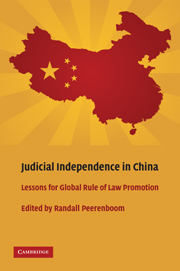Book contents
- Frontmatter
- Contents
- Contributors
- 1 Introduction
- 2 Halfway Home and a Long Way to Go
- 3 A New Approach for Promoting Judicial Independence
- 4 The Party and the Courts
- 5 Judicial Independence in China
- 6 A New Analytic Framework for Understanding and Promoting Judicial Independence in China
- 7 Judicial Independence and the Company Law in the Shanghai Courts
- 8 Local Courts in Western China
- 9 The Judiciary Pushes Back
- 10 Corruption in China's Courts
- 11 A Survey of Commercial Litigation in Shanghai Courts
- 12 Judicial Independence in Authoritarian Regimes
- 13 Judicial Independence in East Asia
- Index
- References
4 - The Party and the Courts
Published online by Cambridge University Press: 05 June 2012
- Frontmatter
- Contents
- Contributors
- 1 Introduction
- 2 Halfway Home and a Long Way to Go
- 3 A New Approach for Promoting Judicial Independence
- 4 The Party and the Courts
- 5 Judicial Independence in China
- 6 A New Analytic Framework for Understanding and Promoting Judicial Independence in China
- 7 Judicial Independence and the Company Law in the Shanghai Courts
- 8 Local Courts in Western China
- 9 The Judiciary Pushes Back
- 10 Corruption in China's Courts
- 11 A Survey of Commercial Litigation in Shanghai Courts
- 12 Judicial Independence in Authoritarian Regimes
- 13 Judicial Independence in East Asia
- Index
- References
Summary
The dominant view among Western legal scholars, human rights activists, and pundits is that the Chinese judiciary lacks meaningful independence in large part because China is a single-party authoritarian state. According to this view, the Chinese Communist Party (CCP) is the main source of interference with the courts and the biggest obstacle to judicial independence. This chapter challenges the prevailing wisdom about the party and its role with respect to judicial independence, legal reforms, and China's efforts to modernize more generally.
The dominant view is the result of analytical and methodological errors typical of Western China watchers' efforts to understand China's legal system and the legal systems in other developing states, authoritarian ones in particular. It is based on four unwarranted assumptions. First, there exists some pure state of reality that deserves to be called judicial autonomy. Second, it is possible to construct a set of standards for, or an objective model of, this judicial autonomy, either as a political structure or as a set of social conventions. Third, this model can show that the CCP exercises political influence on judges and the courts in a way that is inimical to and undermines judicial autonomy. Fourth, it is possible to identify and examine the actual social effect of such influence, and the overall effect of party influence is negative. Rationally considered, however, these suppositions are simply unrealistic.
- Type
- Chapter
- Information
- Judicial Independence in ChinaLessons for Global Rule of Law Promotion, pp. 52 - 68Publisher: Cambridge University PressPrint publication year: 2009
References
- 5
- Cited by

